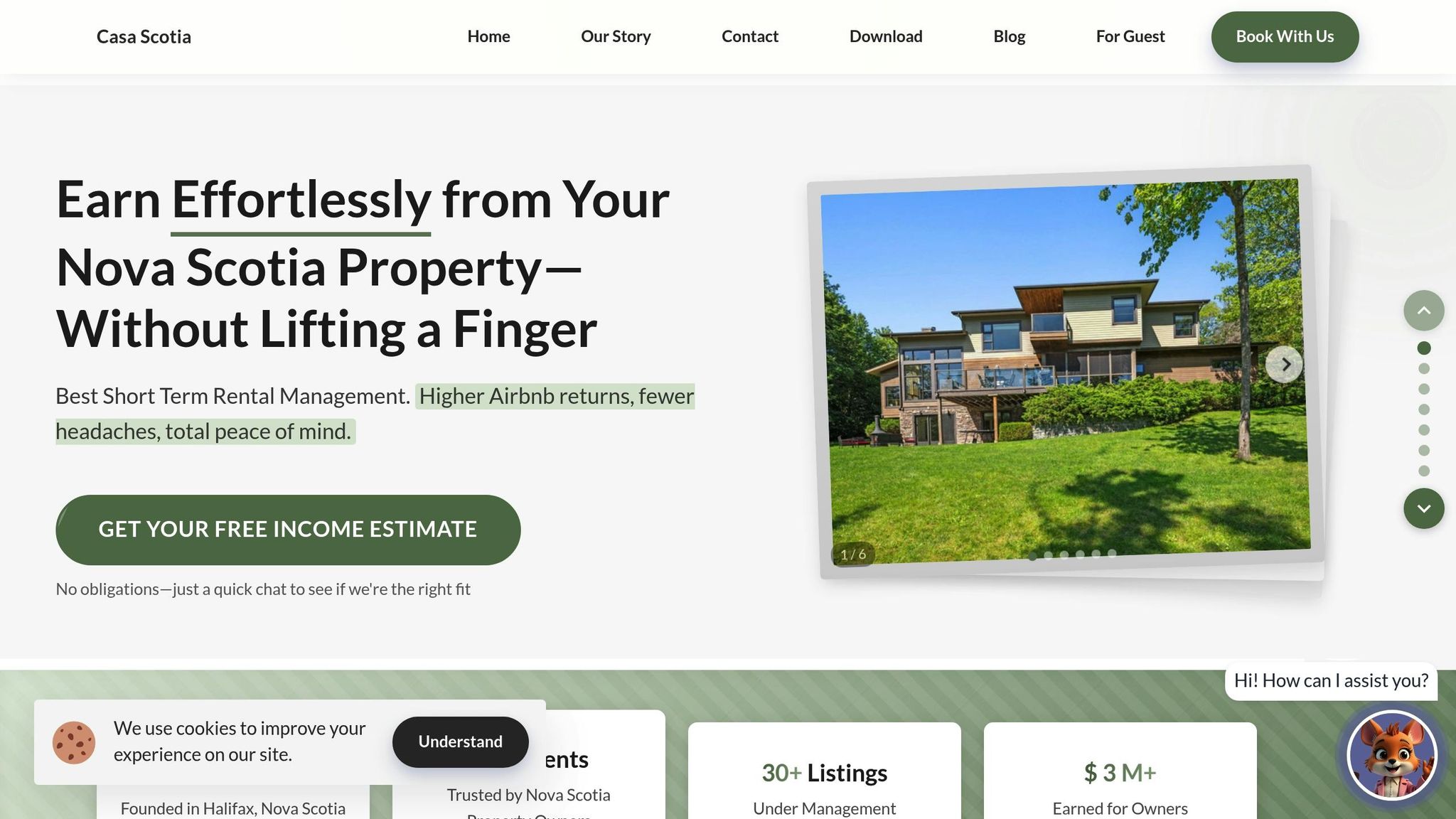Running a short-term rental (STR) in Nova Scotia can be challenging due to seasonal tourism and fluctuating costs. To succeed, you need to know your break-even point - the minimum revenue required to cover monthly expenses - and plan for seasonal changes in demand. This downloadable planner helps STR owners calculate their break-even point, adjust for seasonal trends, and make data-driven decisions.
Key Takeaways:
- Break-even analysis determines how many nights you need to book to cover costs like mortgage, utilities, and cleaning fees.
- Nova Scotia's tourism is highly seasonal, with peak demand in summer (June–September) and slower winters.
- The planner simplifies financial tracking with tools for monthly break-even targets, seasonal pricing, and expense adjustments.
- Seasonal expenses, such as heating in winter or cleaning in summer, can impact profitability and should be factored into your plan.
- Casa Scotia offers support with pricing tools, guest management, and compliance to help STR owners stay competitive.
Start by downloading the planner, inputting your expenses and rates, and tracking your performance monthly to optimize your STR's profitability year-round.
How you see if an investment Airbnb is even worth it in 60 seconds

Data You Need for Break-Even Calculations
To perform an accurate break-even analysis, you’ll need to gather precise financial data. Make sure you have all the relevant costs at hand before diving into the planner.
Financial Data for Break-Even Analysis
Break-even analysis relies on understanding your costs in detail. Start by noting your fixed monthly expenses - these include things like mortgage or financing payments, property taxes, insurance premiums, and basic utilities. Then, account for variable costs, which fluctuate depending on occupancy and seasonal demand. These might include cleaning fees, seasonal utility changes, and booking platform service fees.
Don’t forget about maintenance and supply costs. This can range from consumables and regular upkeep to professional services like property management, accounting, or specialized cleaning. To ensure accurate projections, tailor these figures specifically to your property. Once you’ve gathered all this data, enter it into the planner for a customized break-even analysis. Be sure to format everything in line with local standards.
Canadian Formatting and Units
The planner is set up to follow Canadian conventions, so make sure your data matches. Use the dollar sign ($) in front of amounts, include proper thousand separators, and round to two decimal places. Dates should follow the DD/MM/YYYY format. For property measurements, stick to the metric system - use square metres or hectares for floor areas, Celsius for temperatures, and kilometres for distances. Keeping everything in a familiar format makes it easier to track trends and ensures your analysis is clear and accurate.
Using Real Nova Scotia Market Rates
Beyond detailed cost tracking, incorporating real market rates is key to fine-tuning your projections. In Nova Scotia, seasonal pricing often peaks during the summer months and dips in the winter. Pricing can also vary widely based on location - properties in areas with historical or tourist appeal typically command higher rates. By monitoring your booking data during the first few months of operation, you’ll be able to adjust your estimates to better reflect local market conditions.
How to Calculate Your Break-Even Point
To figure out how much revenue you need to cover your expenses and start making a profit, you'll need to organize your financial data carefully.
Break-Even Calculation Steps
Start by adding up your total monthly operating expenses. This includes both fixed costs (like your mortgage, insurance, and taxes) and variable expenses (such as utilities, cleaning fees, and commissions).
Next, establish your average daily rate (ADR) by researching local market trends. Once you have your ADR, calculate your total rental income by multiplying it by the number of nights your property is booked. For example, if your ADR is $150 and you have 18 booked nights in a month, your total rental income would be $2,700.
Your break-even point is the moment when your total rental income matches your total operating expenses. To make this process easier, you can use the downloadable planner, which automates the calculations and lets you explore different pricing scenarios.
Using the Downloadable Planner
The downloadable planner simplifies everything. Just input your fixed and variable costs, and it automatically calculates your total monthly expenses.
You can also use the planner to map out your seasonal pricing strategy. For instance, you might set a higher ADR for the busy summer months (June through September) and lower rates for the off-peak seasons. Adjust your occupancy rates based on Nova Scotia's tourism trends - busier in the summer and quieter during the winter.
The planner generates monthly break-even charts, showing you which months you're likely to be profitable and which ones may fall short. This insight helps you decide when to tweak your pricing or cut back on expenses.
Tracking Seasonal Changes to Break-Even
Once you've set your baseline break-even point, it's vital to keep an eye on seasonal variations. Nova Scotia’s short-term rental (STR) market experiences noticeable seasonal swings, which will impact your revenue. Use the planner to create separate scenarios for different times of the year to see how your financial outlook shifts.
While your break-even point remains the same, seasonal attendance plays a big role in your actual revenue.
Track your monthly performance and compare it to your projections. Update the planner with real booking data to fine-tune your seasonal forecasts. This will help you identify trends early - maybe your spring bookings are exceeding expectations, or winter demand is weaker than you thought.
The planner also lets you evaluate how seasonal expenses impact your break-even point. For example, heating costs will likely spike during Nova Scotia winters, while summer might bring higher cleaning and maintenance costs due to increased guest turnover. Recognizing these patterns allows you to manage your cash flow and adjust your pricing strategies more effectively.
sbb-itb-b5e1074
Managing STR Seasonality in Nova Scotia
Nova Scotia's tourism industry experiences distinct seasonal patterns, and these fluctuations can have a big impact on your short-term rental income. By understanding these cycles and preparing for them, you can better manage slower months while making the most of peak seasons. Building on your break-even tracking, this section focuses on strategies to handle the ups and downs of seasonal demand.
Forecasting Seasonal Revenue
Once you've identified your costs and break-even point, the next step is to forecast your revenue based on Nova Scotia's tourism trends. Summer is typically the high season for short-term rentals, with popular destinations like Halifax Harbour, Peggy's Cove, and Cape Breton seeing higher occupancy rates and rental prices. Fall still brings moderate revenue, but winter often presents challenges, while spring shows a slow but steady recovery.
Use your planner to refine your monthly revenue goals. Experiment with different ADR (average daily rate) and occupancy rate scenarios to identify which months are likely to perform above your break-even point and which might require extra planning.
Planning for Seasonal Expenses
Operating costs in Nova Scotia can fluctuate throughout the year, and these changes are often tied to the seasons. For instance, heating bills can rise significantly during the winter months, especially for older properties or those with less efficient insulation. In contrast, the summer season may bring higher cleaning costs due to frequent guest turnover, as well as additional spending on outdoor upkeep. Spring often calls for repairs and maintenance to address the wear and tear from winter weather, while insurance premiums for coastal properties might shift depending on seasonal risks.
Break down these seasonal expense variations in your planner to get a clear view of how your break-even point changes month by month. This will help you allocate resources more effectively.
Off-Peak Season Strategies
With your seasonal revenue and expenses mapped out, it’s time to adapt your approach for the quieter months. During periods of lower demand, consider targeting longer-stay guests, such as remote workers or those relocating temporarily. Building partnerships with local businesses can also help you secure consistent referrals.
If low occupancy stretches on, you might temporarily close your property to cut down on expenses. Use this downtime for renovations, deep cleaning, or even personal use. This not only reduces operating costs but can also enhance your property’s long-term value.
Another effective tactic is to tweak your marketing strategy to highlight seasonal perks. For example, emphasize your property’s cozy interiors during the winter or promote proximity to local events happening in the off-season. These adjustments can help attract guests even when demand is lower.
How Casa Scotia Helps with Financial and Operational Planning

Navigating Nova Scotia’s short-term rental (STR) market isn’t just about having a plan - it’s about having the right support to keep your property profitable year-round. Casa Scotia offers a range of management services tailored to help STR owners tackle financial and operational challenges head-on. Let’s dive into how their pricing tools, operational expertise, and management plans can work alongside your break-even strategy.
Casa Scotia's Pricing and Revenue Tools
Casa Scotia’s AI-driven pricing tools take the guesswork out of setting rental rates. By analysing real-time market data specific to Nova Scotia’s seasonal trends, these tools adjust your rates dynamically. They consider factors like neighbourhood demand, competitor pricing, and local market conditions to help you stay competitive throughout the year.
Here’s how it works: During the peak season (June to August), when occupancy rates typically hit 70–80%, the system ensures your property is priced to attract maximum revenue without overpricing. Conversely, during the quieter months (November to March), when occupancy can dip as low as 24.61%, the tools focus on reducing vacancy periods by finding the right balance between price and demand [1].
Owners who use these tools often report fewer vacant days, improving their overall financial performance. Plus, the monthly reports generated by the system give you a clear picture of how rate adjustments impact both revenue and occupancy. This data can be seamlessly integrated into your financial planning, helping you refine your projections for the future.
Operational Support and Compliance Help
Managing the day-to-day operations of an STR can be exhausting, especially during peak seasons. Casa Scotia steps in to handle the operational details that can eat into your profits if neglected. From coordinating cleaning and maintenance to keeping your property guest-ready, they ensure smooth operations even during the busiest times.
One of the standout services is their compliance support. Nova Scotia has strict regulations for STRs, including mandatory registration with the Tourist Accommodations Registry. Fines for non-compliance can range from $1,000 to $100,000 CAD per violation [3]. Casa Scotia helps you navigate these rules, ensuring your property stays within legal boundaries and avoiding costly penalties.
Additionally, their guest screening and communication services take the pressure off during high-demand periods. This allows you to focus on growing your business instead of getting bogged down in daily management tasks.
Casa Scotia's Management Plans for Nova Scotia STR Owners
Casa Scotia offers tailored management plans designed to meet the diverse needs of STR owners in Nova Scotia.
- Year-Round Management: This full-service option is ideal for owners looking for comprehensive support. It includes flexible personal use and mid-term rental options, making it a great choice for capitalizing on the province’s growing tourism industry. With Nova Scotia welcoming 2.2 million tourists in 2023 - a 14% increase from the previous year [3] - this plan ensures you’re well-positioned to benefit from the influx of visitors while managing slower seasons effectively.
- Peak-Season Management: Perfect for owners focused on the high-earning summer months (May through September), this plan helps you maximize revenue during the busiest time of year. It’s especially useful if your break-even analysis shows that your annual profit goals can be met during peak season alone. You’ll also have the option to use your property personally during the quieter months.
Both plans include access to an owner portal, where you can view real-time updates and monthly financial reports. These tools make it easy to track how your property is performing against your break-even targets.
With the average occupancy rate in Nova Scotia at 54% and an average daily rate of $123 (resulting in a RevPAR of $69) [4], Casa Scotia’s expertise can help you optimize these metrics. Their local knowledge is particularly valuable in areas like Inverness, where peak months like August can generate average monthly revenue of $5,576 with 61% occupancy, while February remains the slowest period [2].
Casa Scotia’s approach combines smart pricing, operational efficiency, and tailored management plans to keep your property profitable and compliant in Nova Scotia’s competitive STR market.
Next Steps
Making your short-term rental (STR) profitable starts with knowing your numbers inside and out. The knowledge you’ve gained about break-even analysis and seasonal planning forms the core of your decision-making throughout the year. Now, it’s time to turn those insights into action.
Key Points to Keep in Mind
Break-even analysis is an ongoing process. Regularly updating your figures is essential, especially in Nova Scotia’s ever-changing market. Staying current ensures your strategy remains relevant.
Seasonality planning is a must in Nova Scotia’s tourism market. By pinpointing when demand peaks and when it slows down, you can set realistic revenue goals and manage your cash flow effectively, even during quieter months.
The planner transforms complex numbers into clear insights. It’s a tool that helps you track progress toward your break-even point and prepare for both busy and slower seasons.
Local market knowledge is key. Whether your property is in a bustling city or a tranquil coastal area, understanding neighbourhood trends can help you fine-tune your pricing and marketing strategies for maximum impact.
With these points in mind, it’s time to put your plan into motion.
Take Action Now
Download the Break-Even and Seasonality Planner, enter your data, and start implementing your strategies. Begin by listing your fixed and variable costs, as well as current market rates, to identify your break-even point. Use the seasonal forecasting tools to set revenue goals for the year ahead.
Use these insights to refine your pricing and streamline your STR operations. Adjust your approach based on the data and trends you uncover.
Consider professional support to enhance your STR management. Casa Scotia offers tailored management plans for Nova Scotia STR owners, designed to help you tackle seasonal challenges and improve your overall planning.
Track your progress monthly and adapt your strategy as needed. Successful STR management is a continuous process of improvement, not a one-time effort.
Your Nova Scotia STR has the potential to be a profitable venture. With the right tools and strategies, you’re well on your way to making that potential a reality.
FAQs
How does the Break-Even and Seasonality Planner help me set the right prices year-round?
The Break-Even and Seasonality Planner is a valuable tool for refining your pricing strategy. It provides a clear picture of your costs, revenue projections, and seasonal demand patterns. By pinpointing your break-even point and examining both busy and slower periods, you can adjust your rates strategically to boost income while staying competitive in Nova Scotia's distinct short-term rental market.
This planner helps you prepare for high-demand seasons and quieter times alike, ensuring your financial targets align with market shifts and local trends.
What financial information do I need to prepare before using the Break-Even and Seasonality Planner?
To get the most out of the Break-Even and Seasonality Planner, start by collecting essential financial information. This includes your monthly expenses - like property taxes, utility bills, cleaning costs, and any fees for professional services - and your income records, such as booking confirmations, payment receipts, or bank statements.
Accurate, current data is crucial for the planner to deliver insights that reflect your short-term rental's performance, especially in Nova Scotia's seasonal market.
How does Casa Scotia help STR owners plan for Nova Scotia’s seasonal tourism trends?
Casa Scotia provides a downloadable planner tool specifically crafted for short-term rental (STR) owners in Nova Scotia. This tool is designed to help owners navigate the ebb and flow of seasonal tourism, offering features to evaluate operating costs, predict revenue, and map out strategies for both busy and quieter periods.
By focusing on Nova Scotia’s distinct market dynamics, the planner equips STR owners with the tools they need to fine-tune financial planning and maintain profitability throughout the year.



